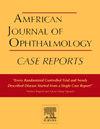Descemet membrane endothelial keratoplasty combined with secondary sulcus hydrophobic intraocular lens implantation
Q3 Medicine
引用次数: 0
Abstract
Purpose
To report a case of combined Descemet membrane endothelial keratoplasty (DMEK) and secondary sulcus hydrophobic intraocular lens (IOL) implantation for hyperopic correction in a pseudophakic eye with Fuchs’ endothelial corneal dystrophy.
Observation
A 74-year-old woman with Fuchs’ dystrophy and a history of phacoemulsification with a hydrophilic IOL in her left eye (refraction: +5.25 D/–1.00 D × 68°; best corrected visual acuity [BCVA]: 20/40) underwent a preparatory yttrium aluminum garnet (YAG) iridotomy followed by implantation of a hydrophobic add-on +8 D IOL in the ciliary sulcus through a 2.4 mm incision. DMEK was performed using a 90 % fill of 10 % sulfur hexafluoride (SF6). Two months after surgery, refraction improved to −0.25 D/–1.75 D × 62° (BCVA: 20/25), with restored corneal clarity and an endothelial cell density of 1920 cells/mm2. At 10 months, refraction was +0.75 D/–1.25 D × 54°, and BCVA further improved to 20/20, with an endothelial density of 1778 cells/mm2 and normalized corneal thickness. No IOL opacification was observed.
Conclusion and importance
This case indicates that combining DMEK with secondary sulcus hydrophobic IOL implantation can effectively correct hyperopia in pseudophakic eyes with Fuchs’ dystrophy.
网膜内皮角膜移植术联合二次沟疏水人工晶状体植入术
目的报道一种联合Descemet膜内皮角膜移植术(DMEK)和继发性沟疏水人工晶状体(IOL)植入术治疗伴有Fuchs角膜内皮营养不良的假性晶状体眼的远视矫正。1例74岁女性,伴有Fuchs营养不良,有超声乳化术史,左眼植入亲水性人工晶体(屈光度:+5.25 D/ -1.00 D × 68°;最佳矫正视力[BCVA]: 20/40)行预备性钇铝石榴石(YAG)虹膜切开术,并通过2.4 mm切口在睫状沟植入疏水附加+ 8d人工晶状体。DMEK采用10%六氟化硫(SF6)填充90%进行。术后2个月,屈光度改善至- 0.25 D/ -1.75 D × 62°(BCVA: 20/25),角膜清晰度恢复,内皮细胞密度为1920个细胞/mm2。10个月时,屈光度为+0.75 D/ -1.25 D × 54°,BCVA进一步改善至20/20,内皮细胞密度为1778个/mm2,角膜厚度归一化。未见人工晶体混浊。结论及重要性本病例提示DMEK联合二次沟型疏水人工晶状体植入术可有效矫正伴有Fuchs营养不良的假性晶状眼远视。
本文章由计算机程序翻译,如有差异,请以英文原文为准。
求助全文
约1分钟内获得全文
求助全文
来源期刊

American Journal of Ophthalmology Case Reports
Medicine-Ophthalmology
CiteScore
2.40
自引率
0.00%
发文量
513
审稿时长
16 weeks
期刊介绍:
The American Journal of Ophthalmology Case Reports is a peer-reviewed, scientific publication that welcomes the submission of original, previously unpublished case report manuscripts directed to ophthalmologists and visual science specialists. The cases shall be challenging and stimulating but shall also be presented in an educational format to engage the readers as if they are working alongside with the caring clinician scientists to manage the patients. Submissions shall be clear, concise, and well-documented reports. Brief reports and case series submissions on specific themes are also very welcome.
 求助内容:
求助内容: 应助结果提醒方式:
应助结果提醒方式:


